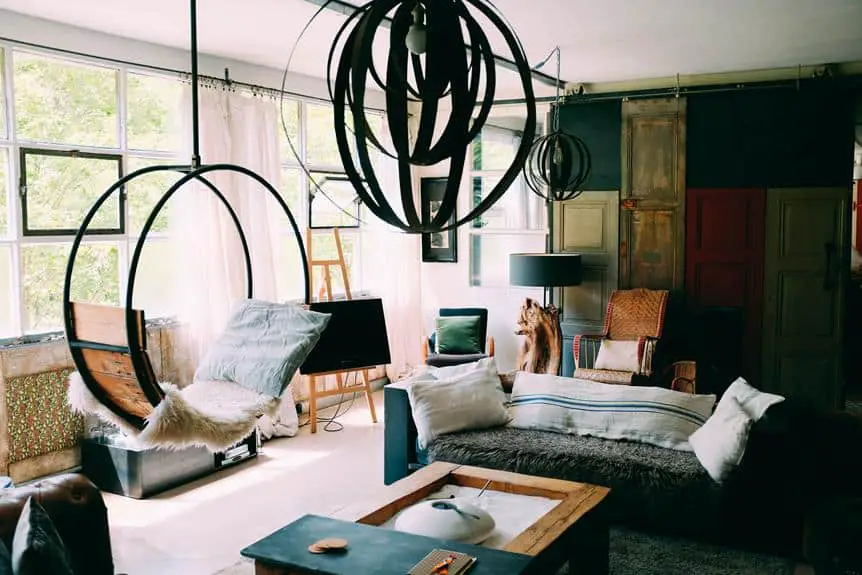To choose artwork for your living room, there are several steps you can follow.
First, measure the room and furniture to find art that fits well. This will help you determine the appropriate size and scale of the artwork.
Next, consider the colors in your decor. You can either pick artwork that matches the existing color scheme or choose pieces that provide a contrast and add visual interest to the room.
In addition to colors, consider selecting themes that match the mood you want to create in the space. For example, if you want a serene and calming atmosphere, you might choose landscapes or abstract art.
Another important factor to consider is your personal style. Choose artwork that reflects your taste and personality. This will help create a space that feels authentic and unique to you.
Once you have chosen your artwork, position it thoughtfully in the room. Consider the placement in terms of composition and balance. The art should enhance the room’s appearance and create a cohesive look.
By following these steps, you can choose artwork that not only fits well in your living room but also adds beauty and personality to the space.
Assessing Space and Scale
When selecting artwork for a living room, it is important to measure the wall space to ensure the art fits well and is proportionate. Art should be a focal point but also blend with the room’s size and decor. Large wall art can be impactful but should not overpower the room.
Choosing wall art requires attention to detail. It should enhance the room’s design and fit with the furniture layout and movement within the space.
A gallery wall is an option that allows for multiple smaller pieces to be displayed together. It should have a consistent color scheme or theme to look unified.
The artwork in a living room should fit with the interior design. Whether a single large piece or multiple smaller ones, the art should add to the room’s atmosphere. Considering room size, lighting, and presentation is key to improving a living space with art that is both attractive and suitable.
Color Coordination Strategies
Selecting the right art for your living room involves matching or contrasting it with the room’s existing colors. Choose a piece that complements or contrasts with the room’s hues. A subtle, textured painting can add depth without being overpowering. Art can also highlight accent colors from items like throw pillows or rugs. An oversized artwork can be a focal point and set the room’s color theme. Make sure the artwork doesn’t clash with the wall color to avoid a disruptive look.
Your art choice should align with your personal style and the room’s decor. For a modern room with neutral colors, consider contemporary prints like James Webb NASA prints for a modern touch. In a traditional setting, choose art with colors that blend with your decor for a unified appearance.
The chosen art should resonate with you and improve the living space, while also fitting within the room’s color scheme and creating the desired emotional effect.
Selecting Complementary Themes
When choosing art for your living room, select themes that match the room’s design and your personal taste. Art should also spark conversations and show careful selection. Match your choice to the room’s style. For example, in a minimalist room with neutral colors, you might pick art with subtle texture differences or abstract shapes. If the room has a lot of natural light, consider calming blue landscapes.
Add personal elements, like family photos or art from places you’ve visited, to make the space feel more welcoming. Combine paintings, prints, and sculptures to give the room variety and depth.
Balancing Personal Taste and Decor
To effectively combine personal taste with existing decor when choosing art for a living room, consider how the art reflects your style and complements the room’s color scheme and design. Opt for large, distinctive pieces that can serve as the room’s centerpiece and create a conversational focal point. These pieces should align with the room’s aesthetic while showcasing individuality.
Creating a gallery wall is an option that allows for a diverse art display. To achieve a cohesive look, select pieces with similar colors or themes. This tactic lets you express varied interests without disrupting the room’s harmony.
When opting for a single statement piece, consider its size, presentation, and style carefully. This piece should highlight your design preferences and stand out, possibly by keeping other walls simpler to draw attention to it.
Incorporating art from the beginning of the living room design process ensures the pieces reflect your personality and enhance the desired atmosphere. Art is not just decorative but a meaningful investment that adds to your home’s identity.
When purchasing art, from galleries or online, research carefully to ensure authenticity and protect your investment.
Understanding Art Placement Dynamics
Art placement in the living room enhances the atmosphere and complements the decor and colors. Properly positioned art contributes to a balanced and personalized space. The size and arrangement of artwork affects the room’s visual appeal.
A large art piece can be a focal point, especially when placed above the sofa, adding color or texture and drawing attention. Smaller artworks can form a gallery wall, displaying a collection with a common story or theme.
The layout of art pieces is critical. A single large piece can ground the space, while multiple small pieces can add diversity. When combining sizes, it’s important to balance them so each retains its significance without dominating the others.
The choice between arranging art in orderly rows or an eclectic gallery style depends on the intended ambiance. Rows create a sense of order and suit modern prints or related images, while an eclectic approach mixes styles and frames, ideal for combining different art periods.





